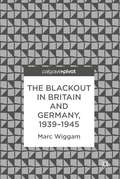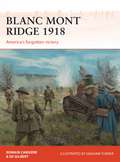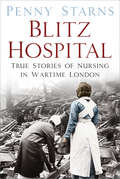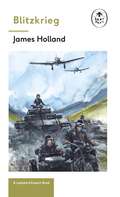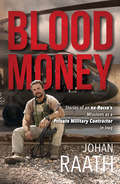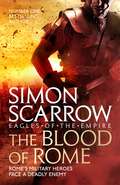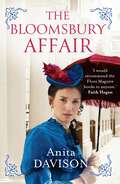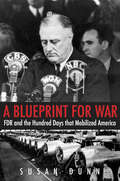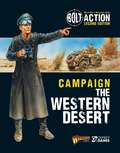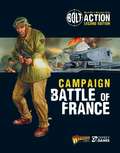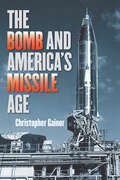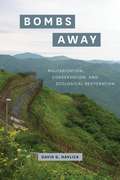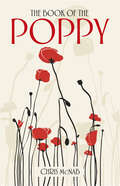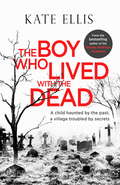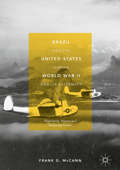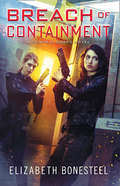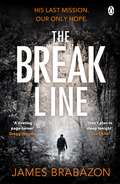- Table View
- List View
The Blackout in Britain and Germany, 1939–1945
by Marc WiggamThis book is the first major study of the blackout in the Second World War. Developing a comparative history of this system of civil defense in Britain and Germany, it begins by exploring how the blackout was planned for in both countries, and how the threat of aerial bombing framed its development. It then examines how well the blackout was adhered to, paying particular regard to the tension between its military value and the difficulties it caused civilians. The book then moves on to discuss how the blackout undermined the perception of security on the home front, especially for women. The final chapter examines the impact of the blackout on industry and transport. Arguing that the blackout formed an integral part in mobilising and legitimating British and German wartime discourses of community, fairness and morality, the book explores its profound impact on both countries.
The Blackout in Britain and Germany, 1939–1945 (PDF)
by Marc WiggamThis book is the first major study of the blackout in the Second World War. Developing a comparative history of this system of civil defense in Britain and Germany, it begins by exploring how the blackout was planned for in both countries, and how the threat of aerial bombing framed its development. It then examines how well the blackout was adhered to, paying particular regard to the tension between its military value and the difficulties it caused civilians. The book then moves on to discuss how the blackout undermined the perception of security on the home front, especially for women. The final chapter examines the impact of the blackout on industry and transport. Arguing that the blackout formed an integral part in mobilising and legitimating British and German wartime discourses of community, fairness and morality, the book explores its profound impact on both countries.
Blanc Mont Ridge 1918: America's Forgotten Triumph (Campaign Ser. #323)
by Graham Turner Romain CansièreThe dominating Blanc Mont Ridge complex in the Champagne region of France was home to some of the most complex German defences on the Western Front. Its heights offered artillery observation that made even approaching the ridge virtually suicidal. Pessimistic about the ability of depleted and demoralized French units to capture the position, Général Henri Gouraud was granted the use of two American divisions: the veteran 2nd "Indianhead†? Division, including the 4th (Marine) Brigade, and the untested 36th "Arrowhead†? Division of the Texas and Oklahoma National Guard. This fully illustrated book describes this Allied offensive with American troops in the vanguard, and shows how despite the heavy losses it sustained to both manpower and supporting armour, they eventually forced the Germans to abandon most of the region in one of the largest withdrawals of the war.
Blitz Hospital: True Stories of Nursing in Wartime London
by Penny StarnsWhen the Blitz hit London, everything changed. Once, the Home Front was relatively safe – now it wasn’t. Suddenly, London was its own front line. Blitz Hospital follows the fortunes of two major London hospitals as they struggled to cope with mounting wartime casualties: St Thomas’ and The London. The diaries, letters and reports of medical and nursing staff highlight the many human stories of tremendous courage and hope that lived and breathed within the corridors of London’s hospitals during the Blitz.
Blitzkrieg: (WW2 #1) (The Ladybird Expert Series)
by Keith Burns James HollandPart of the ALL-NEW Ladybird Expert series.Learn about the fall of Europe in the Second World War in one of the most successful military strategies of modern warfare in this accessible, insightful and authoritative account. Historian, author and broadcaster James Holland draws on the latest research and interviews with participants to bring colour, detail and a fresh perspective to the story.You'll find out how Hitler quickly turned Germany into a war machine: the recruitment of key allies, control over German media, the significance of Poland and military attitudes towards the power of Germany's armies. Inside, you'll discover . . . - Why the Germans allied with the Soviet Union- Why it was so easy for Germany to invade Poland- The propaganda war in Germany, France and Britain- Why the German approach to war was called Bewegungskrieg - The power of radio- And much more . . . Written by the leading lights and most outstanding communicators in their fields, the Ladybird Expert books provide clear, accessible and authoritative introductions to subjects drawn from science, history and culture. For an adult readership, the Ladybird Expert series is produced in the same iconic small hardback format pioneered by the original Ladybirds. Each beautifully illustrated book features the first new illustrations produced in the original Ladybird style for nearly forty years.
Blood Money: Stories of an ex-Recce’s Missions as a Private Military Contractor in Iraq
by Johan Raath‘Shortly after we took off from the check point I saw an old Opel with young men trying to pass us... I remember the cracks of the AK-47 bullets when it came through our windscreen. Our driver drew his pistol and fired back with his right hand while trying to control the speeding vehicle with his left.’Johan Raath and a security team were escorting American engineers to a power plant south of Baghdad when they were ambushed. He had first arrived in Iraq only two weeks before. This was a small taste of what was to come over the next 13 years he worked there as a private military contractor (PMC).His mission? Not to wage war but to protect lives. Raath acted as a bodyguard for VIPs and, more often, engineers who were involved in construction projects to rebuild the country after the 2003 war. His physical and mental endurance was tested to the limit in his efforts to safeguard construction sites that were regularly subjected to mortar and suicide attacks. Key to his survival was his training as a Special Forces operator, or Recce.Working in places called the Triangle of Death and driving on the ‘Hell Run’, Raath had numerous hair-raising experiences. As a trained combat medic he also helped to save people’s lives after two suicide bomb attacks on sites he then worked at.
The Blood of Rome (Eagles Of The Empire Ser. #17)
by Simon ScarrowTHE SUNDAY TIMES BESTSELLERThe gripping new adventure in Simon Scarrow's bestselling Eagles of the Empire series, not to be missed by readers of Conn Iggulden and Bernard Cornwell. It is AD 55. As trouble brews on the eastern fringes of the Roman Empire, Prefect Cato and Centurion Macro prepare for war... The wily Parthian Empire has invaded Roman-ruled Armenia, ousting King Rhadamistus. The King is ambitious and ruthless, but he is loyal to Rome. General Corbulo must restore him to power, while also readying the troops for war with Parthia. Corbulo welcomes new arrivals Cato and Macro, experienced soldiers who know how to knock into shape an undermanned unit of men ill-equipped for conflict.But Rhadamistus's brutality towards those who ousted him will spark an uprising which will test the bravery of the Roman army to the limit. While the enemy watches from over the border...Praise for Scarrow's bestselling novels: 'Blood, gore, political intrigue... A historical fiction thriller that'll have you reaching for your gladius' Daily SportWhat readers are saying about THE BLOOD OF ROME:'Yet another masterful story of the legions by Simon Scarrow''Well-crafted book incorporating fact and fiction. As usual, a great read. Simon Scarrow at his best again''Simon Scarrow is a master of storytelling and rip-roaring adventures. Totally enthralling'
The Bloomsbury Affair (A Flora Maguire Mystery #5)
by Anita Davison1905 London is a heady mix of unimaginable wealth and simmering political tensions, and with war looming Flora Maguire wants to keep her family safe. So when her beloved charge Viscount Edward Trent is accused of murder, she's determined not to leave the investigation to the police. Flora has trodden the path of amateur sleuth before, but with so much at stake, this time it's personal. Slowly the body of the victim found stabbed on a train bound for Paddington starts giving up its secrets, and Flora and her husband Bunny become mired in a murky world of spies, communists and fraudsters. And with the police more sure than ever that Edward is their murderer, Flora must work fast to keep him safe. Anita Davison's compulsive story-telling, combined with the irresistible mix of historical drama and gripping mystery, make this unputdownable.
A Blueprint for War: FDR and the Hundred Days That Mobilized America (The Henry L. Stimson Lectures Series)
by Susan DunnIn the cold winter months that followed Franklin Roosevelt’s election in November 1940 to an unprecedented third term in the White House, he confronted a worldwide military and moral catastrophe. Almost all the European democracies had fallen under the ruthless onslaught of the Nazi army and air force. Great Britain stood alone, a fragile bastion between Germany and American immersion in war. In the Pacific world, Japan had extended its tentacles deeper into China. Susan Dunn dramatically brings to life the most vital and transformational period of Roosevelt’s presidency: the hundred days between December 1940 and March 1941, when he mobilized American industry, mustered the American people, initiated the crucial programs and approved the strategic plans for America’s leadership in World War II. As the nation began its transition into the preeminent military, industrial, and moral power on the planet, FDR laid out the stunning blueprint not only for war but for the American Century.
Bolt Action: Market Garden (Bolt Action #22)
by Warlord Games Peter DennisMarket Garden was a bold plan, designed to capture the Rhine crossings along the Dutch–German border and establish a foothold for an advance into Germany. A massive combined arms operation involving airborne landings and an armoured thrust, it was one of the most dramatic and controversial operations of the war. This new Campaign Book for Bolt Action allows players to command the forces facing each other across the Rhine, fighting key battles and attempting to change the course of history. New, linked scenarios, rules, troop types and Theatre Selectors provide plenty of options for novice and veteran players alike.
Bolt Action: The Western Desert (Bolt Action)
by Warlord Games Peter DennisOne of the most popular and enduring campaigns of World War II is that of the Western Desert, where Allied armies beat back the hard-pressed German and Italian forces under the gruelling African sun. Covering crucial operations such as Crusader, Lightfoot, and Supercharge, and the great battles of Tobruk, El Alamein, and Gazala, this book brings the unforgiving battlefields of North Africa to the tabletop. In-depth information on the forces involved, linked scenarios, and new Theatre Selectors make this an ideal resource for any Bolt Action player with an interest in the Desert War.
Bolt Action: Battle of France (Bolt Action)
by Warlord Games Peter DennisThe Battle of France saw German forces sweep across the Low Countries and towards Paris, crushing Allied resistance in just six weeks. From Fall Gelb and the British withdrawal from Dunkirk to the decisive Fall Rot, this new supplement for Bolt Action allows players to take command of the bitter fighting for France, and to refight the key battles of this campaign. Linked scenarios and new rules, troop types, and Theatre Selectors offer plenty of options for novice and veteran players alike.
Bolt Action: Battle of France (Bolt Action)
by Warlord Games Peter DennisThe Battle of France saw German forces sweep across the Low Countries and towards Paris, crushing Allied resistance in just six weeks. From Fall Gelb and the British withdrawal from Dunkirk to the decisive Fall Rot, this new supplement for Bolt Action allows players to take command of the bitter fighting for France, and to refight the key battles of this campaign. Linked scenarios and new rules, troop types, and Theatre Selectors offer plenty of options for novice and veteran players alike.
The Bomb and America's Missile Age (The Johns Hopkins University Studies in Historical and Political Science #133)
by Christopher GainorThe intercontinental ballistic missile (ICBM), designed to quickly deliver thermonuclear weapons to distant targets, was the central weapons system of the Cold War. ICBMs also carried the first astronauts and cosmonauts into orbit. More than a generation later, we are still living with the political, technological, and scientific effects of the space race, while nuclear-armed ICBMs remain on alert and in the headlines around the world.In The Bomb and America;€™s Missile Age, Christopher Gainor explores the US Air Force;€™s (USAF) decision, in March 1954, to build the Atlas, America;€™s first ICBM. Beginning with the story of the guided missiles that were created before and during World War II, Gainor describes how the early Soviet and American rocket programs evolved over the course of the following decade. He argues that the USAF was wrongly criticized for unduly delaying the start of its ICBM program, endangering national security, and causing America embarrassment when a Soviet ICBM successfully put Sputnik into orbit ahead of any American satellite. Shedding fresh light on the roots of America;€™s space program and the development of US strategic forces, The Bomb and America;€™s Missile Age uses evidence uncovered in the past few decades to set the creation of the Atlas ICBM in its true context;¢;‚¬;€?not only in the America of the postwar years but also in comparison with the real story of the Soviet missiles that propelled the space race and the Cold War. Aimed at readers interested in the history of the Cold War and of space exploration, the book makes a major contribution to the history of rocket development and the nuclear age.
The Bomb and America's Missile Age (The Johns Hopkins University Studies in Historical and Political Science #133)
by Christopher GainorThe intercontinental ballistic missile (ICBM), designed to quickly deliver thermonuclear weapons to distant targets, was the central weapons system of the Cold War. ICBMs also carried the first astronauts and cosmonauts into orbit. More than a generation later, we are still living with the political, technological, and scientific effects of the space race, while nuclear-armed ICBMs remain on alert and in the headlines around the world.In The Bomb and America;€™s Missile Age, Christopher Gainor explores the US Air Force;€™s (USAF) decision, in March 1954, to build the Atlas, America;€™s first ICBM. Beginning with the story of the guided missiles that were created before and during World War II, Gainor describes how the early Soviet and American rocket programs evolved over the course of the following decade. He argues that the USAF was wrongly criticized for unduly delaying the start of its ICBM program, endangering national security, and causing America embarrassment when a Soviet ICBM successfully put Sputnik into orbit ahead of any American satellite. Shedding fresh light on the roots of America;€™s space program and the development of US strategic forces, The Bomb and America;€™s Missile Age uses evidence uncovered in the past few decades to set the creation of the Atlas ICBM in its true context;¢;‚¬;€?not only in the America of the postwar years but also in comparison with the real story of the Soviet missiles that propelled the space race and the Cold War. Aimed at readers interested in the history of the Cold War and of space exploration, the book makes a major contribution to the history of rocket development and the nuclear age.
The Bomb Girl Brides: Is all really fair in love and war? The gloriously heartwarming, wartime spirit saga (The Bomb Girls #4)
by Daisy StylesThe latest Daisy Styles novel___________It's 1944 and Britain is a country at war. The young women of the Phoenix munitions factory are giving their all to the cause, but romance is beckoning . . . The life of a Bomb Girl isn't usually glamourous. But Maggie is getting married, so she is going to make sure her wedding day is - even if she does have to spend every other day slaving on the factory floor. This blasted factory was not what Julia had in mind either. She had always dreamed of attending Oxford University rather than getting her hands dirty and the easy laughter of the other women intimidate her terribly. But they are all here together in this munitions factory in a Lancashire mill town, sharing firsts, pitching in and getting on. Despite rationing, dangerous hard work and new situations these Bomb Girls are going to do their best at work, and in love.
Bombs Away: Militarization, Conservation, and Ecological Restoration
by David G. HavlickWhen viewed from space, the Korean Peninsula is crossed by a thin green ribbon. On the ground, its mix of dense vegetation and cleared borderlands serves as home to dozens of species that are extinct or endangered elsewhere on the peninsula. This is Korea’s demilitarized zone—one of the most dangerous places on earth for humans, and paradoxically one of the safest for wildlife. Although this zone was not intentionally created for conservation, across the globe hundreds of millions of acres of former military zones and bases are being converted to restoration areas, refuges, and conservation lands. David G. Havlick has traveled the world visiting these spaces of military-to-wildlife transition, and in Bombs Away he explores both the challenges—physical, historical, and cultural—and fascinating ecological possibilities of military site conversions. Looking at particular international sites of transition—from Indiana’s Big Oaks National Wildlife Refuge to Cold War remnants along the former Iron Curtain—Havlick argues that these new frontiers of conservation must accomplish seemingly antithetical aims: rebuilding and protecting ecosystems, or restoring life, while also commemorating the historical and cultural legacies of warfare and militarization. Developing these ideas further, he shows that despite the ecological devastation often wrought by military testing and training, these activities need not be inconsistent with environmental goals, and in some cases can even complement them—a concept he calls ecological militarization. A profound, clear explication of landscapes both fraught and fecund, marked by death but also reservoirs of life, Bombs Away shows us how “military activities, conservation goals, and ecological restoration efforts are made to work together to create new kinds of places and new conceptions of place.”
Bombs Away: Militarization, Conservation, and Ecological Restoration
by David G. HavlickWhen viewed from space, the Korean Peninsula is crossed by a thin green ribbon. On the ground, its mix of dense vegetation and cleared borderlands serves as home to dozens of species that are extinct or endangered elsewhere on the peninsula. This is Korea’s demilitarized zone—one of the most dangerous places on earth for humans, and paradoxically one of the safest for wildlife. Although this zone was not intentionally created for conservation, across the globe hundreds of millions of acres of former military zones and bases are being converted to restoration areas, refuges, and conservation lands. David G. Havlick has traveled the world visiting these spaces of military-to-wildlife transition, and in Bombs Away he explores both the challenges—physical, historical, and cultural—and fascinating ecological possibilities of military site conversions. Looking at particular international sites of transition—from Indiana’s Big Oaks National Wildlife Refuge to Cold War remnants along the former Iron Curtain—Havlick argues that these new frontiers of conservation must accomplish seemingly antithetical aims: rebuilding and protecting ecosystems, or restoring life, while also commemorating the historical and cultural legacies of warfare and militarization. Developing these ideas further, he shows that despite the ecological devastation often wrought by military testing and training, these activities need not be inconsistent with environmental goals, and in some cases can even complement them—a concept he calls ecological militarization. A profound, clear explication of landscapes both fraught and fecund, marked by death but also reservoirs of life, Bombs Away shows us how “military activities, conservation goals, and ecological restoration efforts are made to work together to create new kinds of places and new conceptions of place.”
Bombs Away: Militarization, Conservation, and Ecological Restoration
by David G. HavlickWhen viewed from space, the Korean Peninsula is crossed by a thin green ribbon. On the ground, its mix of dense vegetation and cleared borderlands serves as home to dozens of species that are extinct or endangered elsewhere on the peninsula. This is Korea’s demilitarized zone—one of the most dangerous places on earth for humans, and paradoxically one of the safest for wildlife. Although this zone was not intentionally created for conservation, across the globe hundreds of millions of acres of former military zones and bases are being converted to restoration areas, refuges, and conservation lands. David G. Havlick has traveled the world visiting these spaces of military-to-wildlife transition, and in Bombs Away he explores both the challenges—physical, historical, and cultural—and fascinating ecological possibilities of military site conversions. Looking at particular international sites of transition—from Indiana’s Big Oaks National Wildlife Refuge to Cold War remnants along the former Iron Curtain—Havlick argues that these new frontiers of conservation must accomplish seemingly antithetical aims: rebuilding and protecting ecosystems, or restoring life, while also commemorating the historical and cultural legacies of warfare and militarization. Developing these ideas further, he shows that despite the ecological devastation often wrought by military testing and training, these activities need not be inconsistent with environmental goals, and in some cases can even complement them—a concept he calls ecological militarization. A profound, clear explication of landscapes both fraught and fecund, marked by death but also reservoirs of life, Bombs Away shows us how “military activities, conservation goals, and ecological restoration efforts are made to work together to create new kinds of places and new conceptions of place.”
Bombs Away: Militarization, Conservation, and Ecological Restoration
by David G. HavlickWhen viewed from space, the Korean Peninsula is crossed by a thin green ribbon. On the ground, its mix of dense vegetation and cleared borderlands serves as home to dozens of species that are extinct or endangered elsewhere on the peninsula. This is Korea’s demilitarized zone—one of the most dangerous places on earth for humans, and paradoxically one of the safest for wildlife. Although this zone was not intentionally created for conservation, across the globe hundreds of millions of acres of former military zones and bases are being converted to restoration areas, refuges, and conservation lands. David G. Havlick has traveled the world visiting these spaces of military-to-wildlife transition, and in Bombs Away he explores both the challenges—physical, historical, and cultural—and fascinating ecological possibilities of military site conversions. Looking at particular international sites of transition—from Indiana’s Big Oaks National Wildlife Refuge to Cold War remnants along the former Iron Curtain—Havlick argues that these new frontiers of conservation must accomplish seemingly antithetical aims: rebuilding and protecting ecosystems, or restoring life, while also commemorating the historical and cultural legacies of warfare and militarization. Developing these ideas further, he shows that despite the ecological devastation often wrought by military testing and training, these activities need not be inconsistent with environmental goals, and in some cases can even complement them—a concept he calls ecological militarization. A profound, clear explication of landscapes both fraught and fecund, marked by death but also reservoirs of life, Bombs Away shows us how “military activities, conservation goals, and ecological restoration efforts are made to work together to create new kinds of places and new conceptions of place.”
The Book of the Poppy
by Chris McNabThe Remembrance Poppy is a haunting reminder of the ultimate cost of war. Worn by millions around the world every year, the Poppy compels us to remember war’s dead, wounded and bereaved, regardless of nationality or conflict. As we reflect on the centenary of the First World War, this book charts the history of the Remembrance Poppy, from its origins in the battle-tortured landscape of Flanders in 1915 to its enduring relevance in the present day. It sets the Poppy in its context of tragedy and sacrifice, always acknowledging that our war dead are gone, but not forgotten.
The Boy Who Lived with the Dead (Albert Lincoln #2)
by Kate EllisA child haunted by the past. A village troubled by secrets.'A powerful story of loss, malice and deception' Ann CleevesThe second historical thriller in the Albert Lincoln series by bestselling crime writer Kate Ellis. 1920. Scotland Yard detective DI Albert Lincoln is still reeling from the disturbing events of the previous year when he's called away from London to a new case in the North West of England. Before the War he led the unsuccessful investigation into the murder of little Jimmy Rudyard in the village of Mabley Ridge. Now a woman has been murdered there and another child is missing, the sole witness being a traumatised boy who lives in a cemetery lodge. Albert is determined that this time him he will find the truth . . . and the missing child.When Albert delves into the lives of the village residents he uncovers shocking secrets and obsessions. Then, as more bodies are discovered, he realises that his young witness from the cemetery lodge is in grave danger, from somebody he calls 'the Shadow Man'.As Albert discovers more about the victims he finds information that might bring him a step closer not only to Jimmy's killer but to solving a mystery of his own: the whereabouts of his lost son.What readers are saying about The Boy Who Lived with the Dead:'Outstanding' Goodreads reviewer, 5 stars'A fantastic read which kept me guessing right until the last few pages' Goodreads reviewer, 5 stars'Superb!' Goodreads reviewer, 5 stars'Compulsive reading . . . very cleverly constructed with plenty of twists' Goodreads reviewer, 5 stars'Hard to put the book down' Goodreads reviewer, 5 stars'[Kate Ellis] must be a genius' Goodreads reviewer, 5 stars'Excellent' Goodreads reviewer, 5 stars
Brazil and the United States during World War II and Its Aftermath: Negotiating Alliance and Balancing Giants
by Frank D. McCannThe military alliance between the United States and Brazil played a critical role in the outcome of World War II, and yet it is largely overlooked in historiography of the war. In this definitive account, Frank McCann investigates Brazilian-American military relations from the 1930s through the years after the alliance ended in 1977. The two countries emerge as imbalanced giants with often divergent objectives and expectations. They nevertheless managed to form the Brazilian Expeditionary Force and a fighter squadron that fought in Italy under American command, making Brazil the only Latin American country to commit troops to the war. With the establishment of the US Air Force base in Natal, Northeast Brazil become a vital staging area for air traffic supplying Allied forces in the Middle East and Asian theaters. McCann deftly analyzes newly opened Brazilian archives and declassified American intelligence files to offer a more nuanced account of how this alliance changed the course of World War II, and how the relationship deteriorated in the aftermath of the war.
Breach of Containment: A Central Corps Novel (A Central Corps Novel #3)
by Elizabeth BonesteelA reluctant hero must prevent war in space and on Earth in this fast-paced military science fiction thriller from the author of The Cold Between and Remnants of Trust.
The Break Line: The impossible to put down thriller. 'Don't plan to sleep tonight' Lee Child
by James Brabazon'Breathless, complex and seriously hardcore - don't plan to sleep tonight' Lee Child ______________ Officially Max Mclean doesn't exist. The British government denies all knowledge of the work he does on their behalf to keep us safe. But Max and his masters are losing faith in each other. And they've given him one last chance to prove he's still their man. Sent to a military research facility to meet a former comrade-in-arms, Max finds the bravest man he ever knew locked up for his own protection. His friend lost his mind during an operation in West Africa. The reason? Absolute mortal terror. Max is determined to find out why. Ahead lies a perilous, breathtaking mission into the unknown that will call into question everything that Max once believed in. Acting alone, without back-up, Max lands in Sierra Leone with his friend's last words ringing in his ears: 'They're coming, Max. They're coming . . .' The Break Line is a debut dripping with authenticity and menace. Smart, unputdownable and packed with irresistible set pieces and jaw-dropping plot twists, this is a thriller like no other. ______________'A riveting page turner, a gruesome delight, and a study of what lies in the shadowed corners of the human heart' Gregg Hurwitz, author of Orphan X'A taut, razor-edged thriller, packed with granular detail and authenticity' JAMES SWALLOW, author of NOMAD'Brutally compelling . . . Andy McNab meets Heart of Darkness' Mail on Sunday
